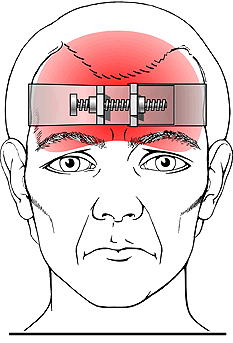Page Contents
- 1 WHAT IS IT?
- 2 WHAT CAUSES IT?
- 3 WHY IS IT A PROBLEM?
- 4 WHAT MAKES US SUSPECT IT?
- 5 CLINICAL WORKUP
- 6 HOW DO WE RULE OTHER DIAGNOSES OUT?
- 7 HOW DO WE TREAT IT?
- 8 HOW WELL DO THE PATIENTS DO?
- 9 WAS THERE A WAY TO PREVENT IT?
- 10 WHAT ELSE ARE WE WORRIED ABOUT?
- 11 OTHER HY FACTS?
- 12 ARCHIVE OF STANDARDIZED EXAM QUESTIONS
- 13 FURTHER READING
WHAT IS IT?
Tension headache refers to a particular type of headache that is often characterized by the feeling of “band-like” pain around the head.

WHAT CAUSES IT?
The exact cause is unknown however precipitating factors can include the following:
- Stress
- Sleep deprivation
- Hunger
- Eye strain
WHY IS IT A PROBLEM?
These types of headaches can be a nuisance to patients.
WHAT MAKES US SUSPECT IT?
Risk factors
Stress, emotional disturbance
Initial Presentation
Common Chief Complaints:
- Headache (bilateral)
History Of Present Illness
Headache can be characterized by:
- Precipitants: stress, sleep deprivation, hunger, and eye strain
- No aura before the onset of symptoms
- Onset: often begins in the morning, and worsens during the day. Constant headache.
- Location: typically bilateral
- Quality: “band-like” pain around the head/bilateral pressure
- Duration: typically 4-6 hours
- Photophobia uncommon
- Phonophobia uncommon
- Nausea/vomiting are uncommon but mild nausea may develop with chronic headache
Physical Exam Findings
HEENT: pericardial muscle tenderness on palpation is one of th more common abnormal exam findings.
Neurological exam should be completely unremarkable
Fundoscopy should also be unremarkable
CLINICAL WORKUP
Diagnosis of exclusion that is made based upon the clinical characteristics described above (and is made in the absence of any other neurological findings).
HOW DO WE RULE OTHER DIAGNOSES OUT?
Fundoscopy should be performed to evaluate for papilledema (that can suggest increased intracranial pressure, which is not explained by tension headache).
HOW DO WE TREAT IT?
Acutely the goal of treatment here is to control the pain of the patient
Hot baths/relaxation/massage can sometimes receive the headaches in patients.
NSAIDs can be used to manage patient symptoms
Acetaminophen can also be used to manage symptoms.
Chronic management should target addressing the precipitating factors of the headache
Regular diet/exercise can be suggested to patients
HOW WELL DO THE PATIENTS DO?
This condition is not fatal, however affected patients can suffer from lost productivity and functional impairment.
WAS THERE A WAY TO PREVENT IT?
While not alway practical, avoiding precipitants (stress, hunger, poor sleep, eye strain) can sometimes prevent these headaches from occurring.
WHAT ELSE ARE WE WORRIED ABOUT?
Medication overuse headache/rebound headache: the overuse of pain medication to receive this condition can result in the development of rebound headache when the main medications are ceased.
OTHER HY FACTS?
Most common type of headache!
ARCHIVE OF STANDARDIZED EXAM QUESTIONS
This archive compiles standardized exam questions that relate to this topic.
FURTHER READING
Page Updated: 07.25.2016